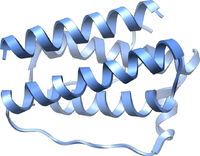
Photo from wikipedia
Differences in glucose uptake in peripheral and neural tissues account for the reduced efficacy of insulin in nervous tissues. Herein, we report the design of short peptides, referred as amino… Click to show full abstract
Differences in glucose uptake in peripheral and neural tissues account for the reduced efficacy of insulin in nervous tissues. Herein, we report the design of short peptides, referred as amino acid compounds (AAC) with and without a modified side chain moiety. At nanomolar concentrations, a candidate therapeutic molecule, AAC2, containing a 7-(diethylamino) coumarin-3-carboxamide side-chain improved glucose control in human peripheral adipocytes and the endothelial brain barrier cells by activation of insulin-insensitive glucose transporter 1 (GLUT1). AAC2 interacted specifically with the leptin receptor (LepR) and activated atypical protein kinase C zeta (PKCς) to increase glucose uptake. The effects induced by AAC2 were absent in leptin receptor-deficient predipocytes and in Leprdb mice. In contrast, AAC2 established glycemic control altering food intake in leptin-deficient Lepob mice. Therefore, AAC2 activated the LepR and acted in a cytokine-like manner distinct from leptin. In a monogenic Ins2Akita mouse model for the phenotypes associated with type 1 diabetes, AAC2 rescued systemic glucose uptake in these mice without an increase in insulin levels and adiposity, as seen in insulin-treated Ins2Akita mice. In contrast to insulin, AAC2 treatment increased brain mass and reduced anxiety-related behavior in Ins2Akita mice. Our data suggests that the unique mechanism of action for AAC2, activating LepR/PKCς/GLUT1 axis, offers an effective strategy to broaden glycemic control for the prevention of diabetic complications of the nervous system and, possibly, other insulin insensitive or resistant tissues.
Journal Title: Biomaterials
Year Published: 2020
Link to full text (if available)
Share on Social Media: Sign Up to like & get
recommendations!